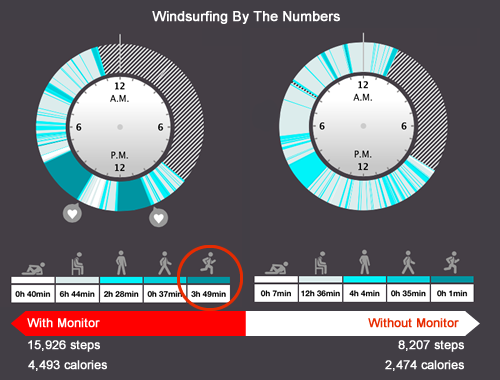I fear I may be obsessed with my wearable device, or more accurately, by the data that it generates about my daily activity. It started at CES in January, where I started tracking my steps. Just how many steps does one take while traipsing around an electronics show? More to the point, could I do more steps than the day before? I was hooked.
But then I started to discover the limitations of this approach: a mountain bike jaunt cannot be measured through step measurement, although some enterprising people attach the wearable to their ankle to try and track this activity more effectively. That may work within the gym, but out on the trail, I achieved over 10,000 “steps” in a one hour session thanks to the roughness of the trail. On the one hand, that deserved a metaphorical pat on the back (and a quick candy break, ahem); on the other hand, I knew that the data was complete nonsense in all real senses.
Which brings us to the latest must-have sensor: the heart-rate monitor. The first generation of fitness bands have been targeted primarily at walkers and runners; the next generation needs to support a wider range of activities for the metric-measuring multisport fanatics (or the metric-obsessed in my case). After all, if I’m going to track my “big data” then I want it to be accurate across all of my (hopefully) calorie-chewing activities.
And boy, can it be worth it. I “field tested” a heart rate solution while windsurfing in the Caribbean (it is a hard life). On day one, ignoring the sniggers of some of my windsurfing colleagues, I wore a chest heart rate monitor in addition to the activity band I usually wear; on the second day I windsurfed without the heart monitor (but still wearing the activity band). The differences in data were stunning: in terms of “steps” and the associated calculations for calories, I struggled to meet my daily goal on the second day, while the more accurate heart measurement told me I burned more than 4,000 calories and achieved 600 percent of my goal (while still having a similar number of overall steps). Guess which one I’m going to believe?
By day three I was routinely ignoring the wisecracks of those around me, happy in the knowledge that I knew how well I was burning calories, even if most of them came from chasing after my board after falling off. But clearly the chest band is not going to be an optimum solution for us data freaks moving forward, particularly those of us that want to live somewhat in denial about our need for numbers. Cue the newest innovation in heart-rate tracking: the wrist-worn monitor. Smartwatches such as Basis have offered this for a while, and Samsung has made a splash by adding this sensor to its latest Gear and Gear Fit devices. But a more interesting variation is the MioGlobal wrist monitor, which is just a heart monitor, and nothing else.
This fits with the theory that wearable technology needs to migrate from a mind-set of being a single device to a more distributed, creating a personal area network of devices, with each one specializing in different functionality. After all, I only really need to track my heart data while exercising. Sitting on my rear while typing this blog doesn’t require such tracking (the blog isn’t that exciting).
And so, to the final point: what exactly do I need all of this data for anyway? Well, in my case the return on investment is really easy: windsurfing is proving to be THE best form of calorie burning, fitness-driving exercise I can find. Which means that I have the perfect excuse to head out on the water more often: it’s not for fun (ahem), but purely for the health benefits. See you on the water…
